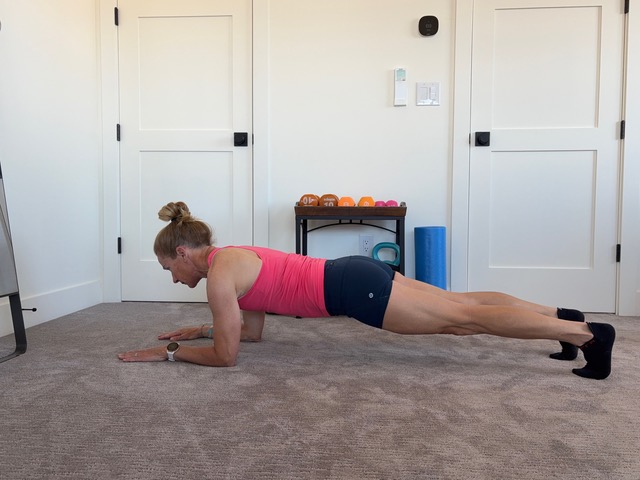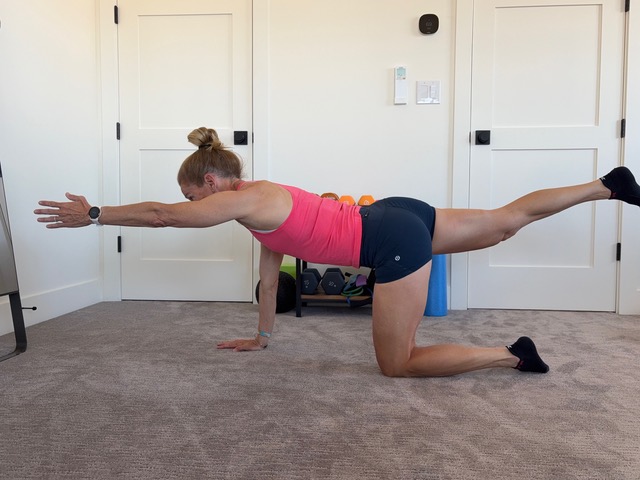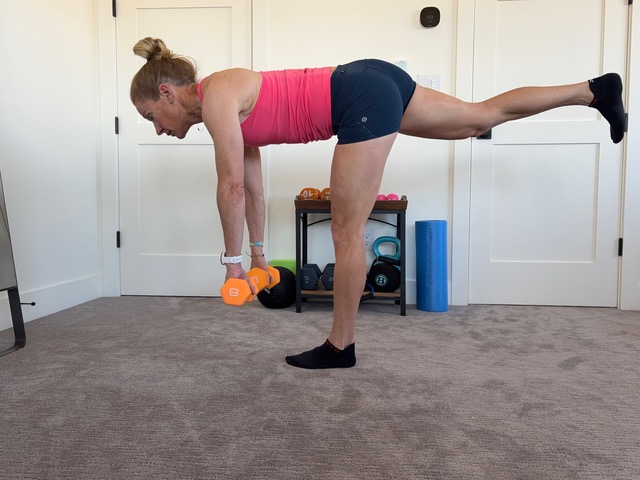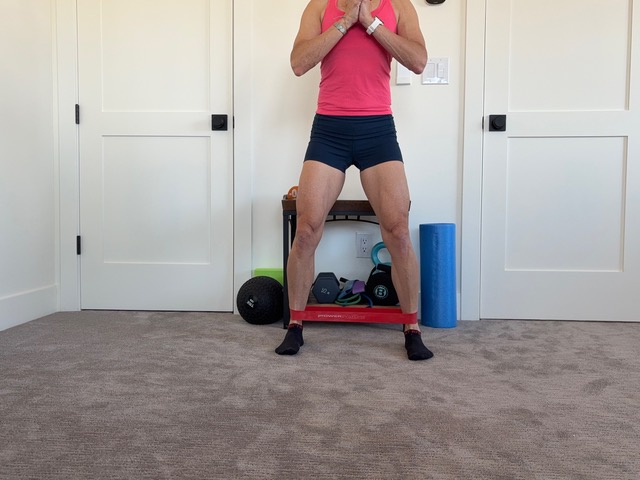By Windy City Angels Coach, Deanna McCurdy
I admit, I am a cardio junkie. I not only love the feeling of arms and legs pumping in fluid motion, filling my lungs with oxygen, and traversing surfaces over distance, whether on foot, by bike or in the water. I crave the escape and mental “therapy” time I get when I am outside sweating through a workout. Over the years I have acquired dumbbells, a weight bench, a myriad of exercise balls and kettlebells to add to my arsenal of exercise equipment, but use them almost reluctantly when I can’t get outside to get my cardio fix. That being said, skipping out on doing strength and mobility work is something I do not do. For me, its like dental flossing… I need to floss more than I do, but I know that if I don’t floss, the repercussions can be much worse than taking the few extra minutes before going to bed to clean between my teeth.
As many of you may or may not know, I am 50 years old and mom to a 17 year old Angel. I have been a competitive endurance athlete for over 35 years -wow, just writing that makes me sound old. Good thing I don’t feel (or act) my age most of the time! One thing I wish I did when I was younger, but do religiously since my late 30’s is incorporate strength and mobility training into my weekly routine. It truly is just as important as cardiovascular exercise is to developing, maintaining and building overall health and fitness… and is essential for keeping my body healthy and injury free caring for my now much larger Angel.
While in the off or early building season, I follow more of a heavier weight lifting routine, which is vital to building muscle and connective tissue strength, preventing injury, increasing bone density, and boosting metabolism. For women, especially those who are in peri- and post-menopause, this is especially important… but I won’t dig deeper into that here. Feel free to reach out to me if you want to know more about it and my thoughts during this “wild and crazy” hormonal roller coaster stage of life. Once my training shifts to race or goal specific workouts, I still do strength work 1-2 times/week and mobility exercises daily, but shift the focus from building to more maintenance and injury prevention.
Strength training “in season” – and yes, if you are participating in an Angelman Strong 5K in May or beginning to ramp up your mileage as you prepare to start your formal training for the Chicago marathon, you are “in season” or just about to be in season now- doesn’t have to be time consuming, complicated, or require the use of much equipment. In season strength training can take as little as 15-20 minutes, twice/week and be done while watching tv at night… or even as creatively as in your child’s playroom while they are monkeying around with their toys.
Below are a list of a 5 basic strength exercises that focus on strengthening the core and hips, areas where weakness could lead to increased risk of injury.
1. Plank (prone and side plank): Planks are a full body exercise that engage your core muscles- abdominals, back, glutes, legs, chest and arms.
Imagine your body being a board while doing a plank, keeping a straight line running from top of your head down to your toes. Engage your core muscles (think of how you would tighten your abdominals right before someone is about to punch you in the gut). If you feel your stomach sagging or hips dropping, stop and regroup before starting again. Planks can be held for as little as10-15 sec or as long as minutes. Side planks, similar to prone planks, engage the core- abs and back, as one lifts off the ground in side-lying. Your grounded arm can be propped up on your elbow if you have wrist issues or fully extended. If your lower hip begins to drop toward the ground, stop and regroup so as not to aggravate the back.
2. Bird dog: Bird dog engages similar muscle groups as planks do, but adds a component of unilateral and cross lateral stability. When we walk or run, we have to balance on 1 leg while diagonally rotating our upper body. Exercises like bird dog help maintain stability for when we put our body through repetitive unilateral movement.
Bird dog involves starting in quadruped, or on all 4’s, then raising the opposite arm and leg and extending them straight out in front and behind. The key is to engage your core so you keep your shoulders and hips parallel to the floor, not twisting, rotating or letting your stomach drop.
3. Unilateral bridging: Unilateral exercises train to build hip and leg strength independently to support your body weight on a run. Most people tend to have a stronger, more dominant side and a weaker side. Repetitive motion and only focusing on bilateral strength training movements (squats, deadlifts, pushups) will allow the more dominant side to compensate for the weaker side. Over time, this compensatory patterns can lead to injury so it is important to also add exercises that help develop the muscles of one’s weaker side.
Similar to basic bridging, start by lying on your back with one leg bent and the other outstretched. Engage your core muscles, then slowly lift your butt up off the ground, squeezing the glutes as you do so. The goal is to keep both sides of the pelvis level with each other as you lift and form a straight line from your shoulders through your hips, and extended leg.

4. Single leg tip-overs or single leg Roman dead lifts (RDL): As mentioned with unilateral bridging, running is ultimately a repetitive series of balance and controlled falls from 1 leg to the other. Training to balance on a leg engages the intrinsic muscles around the ankle, knee and hip as well as engages the core (without core engagement, you will fall over).
Start a single leg RDL standing like a flamingo on 1 leg. Find your balance point before engaging in any movement. I prefer to do these – and all strength training- barefoot so the proprioceptors in my feet work to find balance points. Once stable, slowly bend from the hip, bringing your upper body parallel to the ground, outstretching the unweighted leg. Keep your back straight and head neutral to help with balance and correct technique. As you return to your starting position, think about squeezing the glute muscles on the grounded leg.
5. Sidestepping with an exercise band: So many runners, women specifically, can develop knee issues and aggravate their IT bands as they begin to fatigue during a run. Why? Women have large Q angles than men (the angle created between where the femur connects with the pelvis and knee joint). Not to be sexist, but women’s pelvis’s were designed for bearing children where as men’s hip to knee angle is much less of an angle. As runner’s fatigue, often the knee crosses over midline during a stride, placing strain on the IT band – a thick band of connective tissue that runs from the hip down to the outside of the knee. Usually pain is felt from the friction of the IT band rubbing across the outside of the knee. By strengthening the hip abductors, including the gluteus medius, maximus and TFL (tensor fascia latae), one’s running stride is less likely to become compensated with increased mileage.
Place an exercise band around the lower thigh, just above but not on the knee joint, around the ankles, or the midsole of the feet (play around for what feels most comfortable for you and targets your weaker muscle focus). Bend slightly at the hip and through the knees and with your hands on your hips to make sure they stay the same height, then step laterally.
*Note: if you do not own an exercise band, you can do side-lying leg lifts to accomplish similar muscle group engagement. Make sure your hips stay aligned, perpendicular to the ground and slowly lift the top leg up and down, maintaining a straight line from your shoulder, hip and lower leg.
Strength training doesn’t have to be hard, complex, or involve a lot of time and equipment, but it is essential for a healthy body and life. If you want to be a stronger, faster runner: strength train. If you want to continue moving as you age: strength train. If you want to sleep well without aches and pains: strength train. If you want to decrease chances of injury care taking for a loved one: strength train. Embrace strength training as part of your weekly routine and not only will you become a stronger runner, you will ensure your body remains strong and resilient for years to come.

Deanna McCurdy
Windy City Angels – Angelman Syndrome Foundation Coach
Miles for Smiles- Wings to Fly Head Coach
USAT Level I, USAC Level II certified coach
Cell: (720) 603-3315
“Sometimes an Angel needs a little help to Fly.”





